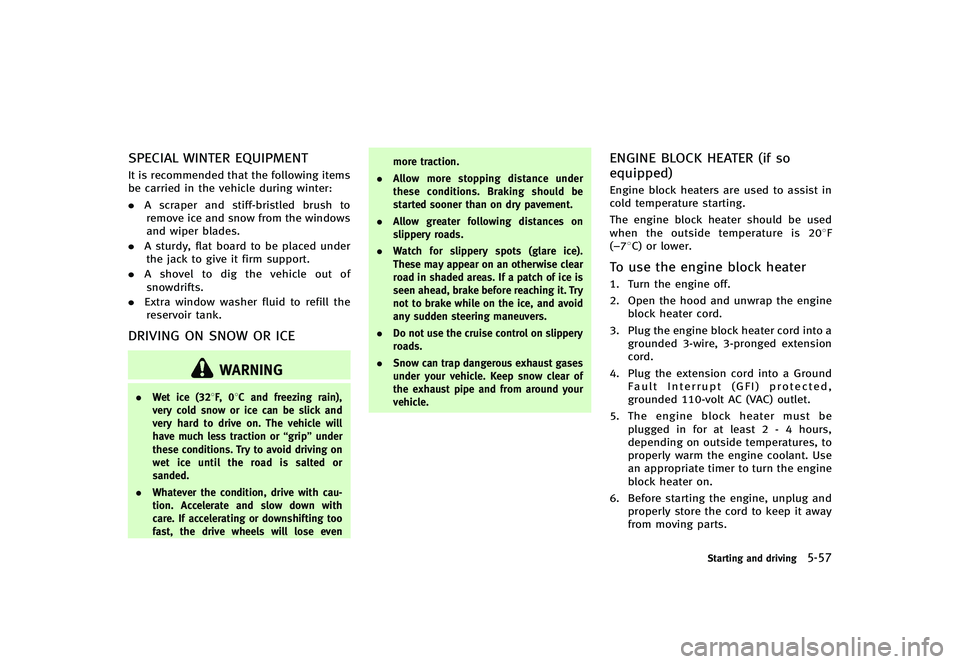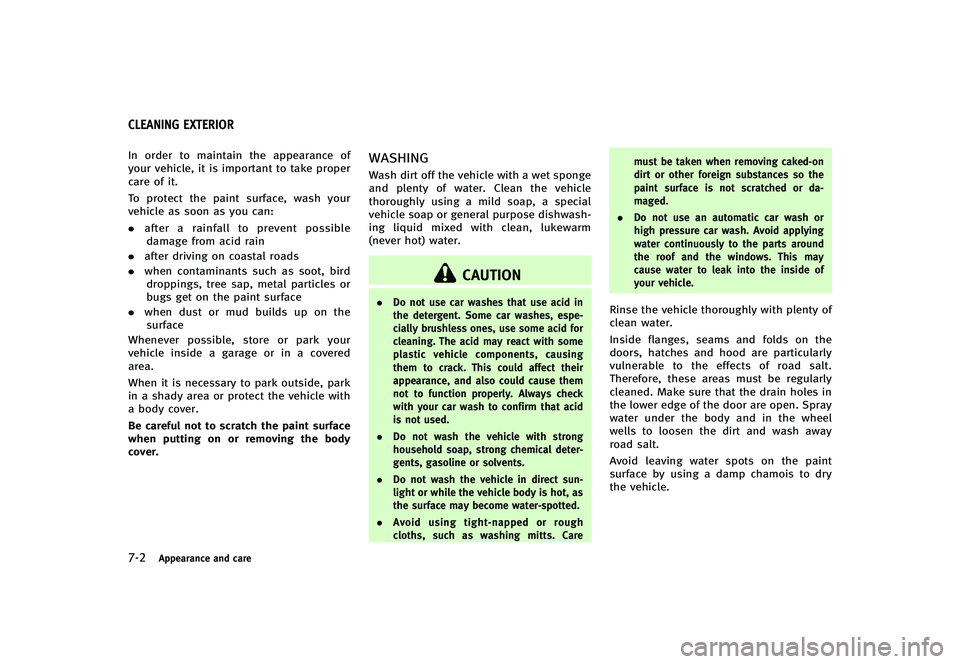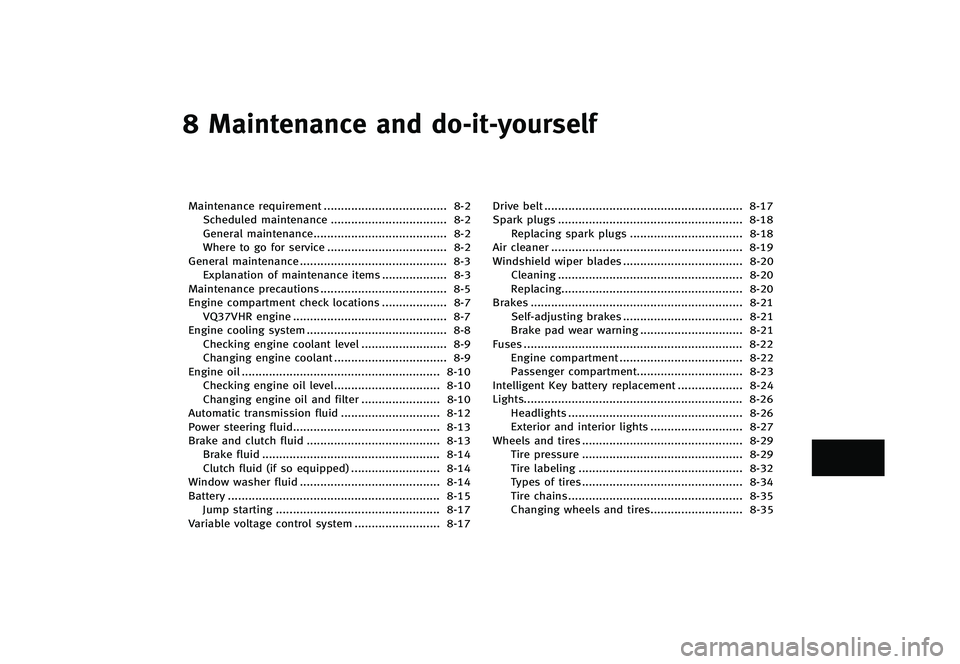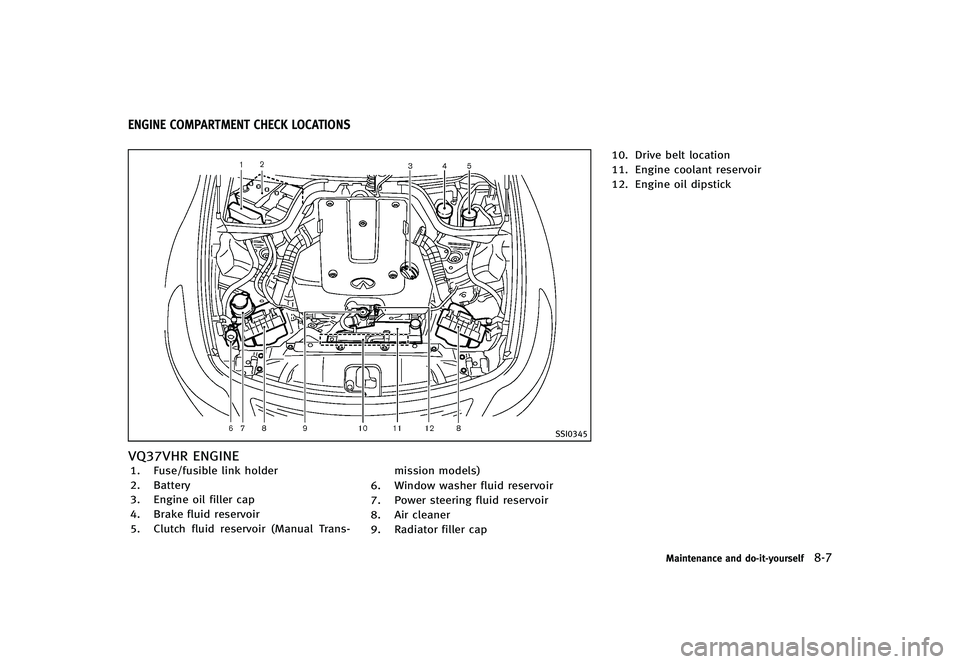window INFINITI G-CONVERTIBLE 2012 Workshop Manual
[x] Cancel search | Manufacturer: INFINITI, Model Year: 2012, Model line: G-CONVERTIBLE, Model: INFINITI G-CONVERTIBLE 2012Pages: 474, PDF Size: 3.63 MB
Page 354 of 474

retailer.
PREVIEW FUNCTION (for Intelligent
Cruise Control system equipped
models)
GUID-32536B6C-4378-49EB-9FE2-8A7EE457E3F0The ICC system with the preview function
identifies the need to apply emergency
braking by sensing the vehicle ahead in
the same lane and the distance to the
vehicle ahead and relative speed from it, it
applies the brake pre-pressure before the
driver depresses the brake pedal and helps
improve brake response by reducing pedal
free play.
For more details, see“Brake assist”(P.5-
51).
GUID-80396E4C-7829-4CC4-B140-AD5C5CA0C471
CAUTION
During the first 1,200 miles (2,000 km),
follow these recommendations to obtain
maximum engine performance and ensure
the future reliability and economy of your
new vehicle.
Failure to follow these recommendations
may result in shortened engine life and
reduced engine performance.
. Avoid driving for long periods at con-
stant speed, either fast or slow. Do not
run the engine over 4,000 rpm.
. Do not accelerate at full throttle in any
gear.
. Avoid quick starts.
. Avoid hard braking as much as possi-
ble.
GUID-A0B243EA-7BDA-4E12-AEC1-2F8D7AC85AA5. Accelerate slowly and smoothly. Main-
tain cruising speeds with a constant
accelerator position.
. Drive at moderate speeds on the high-
way.
. Avoid unnecessary stopping and brak-
ing. Keep a safe distance behind other
vehicles.
. Select a gear range suitable to road
conditions.
. Avoid unnecessary prolonged engine
idling.
. Keep your engine tuned up.
. Follow the recommended periodic main-
tenance schedule.
. Keep the tires inflated at the correct
pressure. Improper tire pressure will
increase wear and waste fuel.
. Make sure the front wheels are properly
aligned. Improper alignment will cause
premature tire wear and lower fuel
economy.
. Climate control operation lowers fuel
economy. Use the air conditioner only
when necessary.
. When cruising at highway speeds, it is
more economical to use the air condi-
tioner and leave the windows closed to
reduce drag.
Starting and driving5-45
BREAK-IN SCHEDULE INCREASING FUEL ECONOMY
Page 366 of 474

SPECIAL WINTER EQUIPMENTGUID-9E63915B-AEEB-4DF7-AE59-93BA4A80CE83It is recommended that the following items
be carried in the vehicle during winter:
.A scraper and stiff-bristled brush to
remove ice and snow from the windows
and wiper blades.
. A sturdy, flat board to be placed under
the jack to give it firm support.
. A shovel to dig the vehicle out of
snowdrifts.
. Extra window washer fluid to refill the
reservoir tank.
DRIVING ON SNOW OR ICEGUID-B958E8BB-93DC-4740-87FE-FFE84942F1FF
WARNING
. Wet ice (328F, 08C and freezing rain),
very cold snow or ice can be slick and
very hard to drive on. The vehicle will
have much less traction or “grip”under
these conditions. Try to avoid driving on
wet ice until the road is salted or
sanded.
. Whatever the condition, drive with cau-
tion. Accelerate and slow down with
care. If accelerating or downshifting too
fast, the drive wheels will lose even more traction.
. Allow more stopping distance under
these conditions. Braking should be
started sooner than on dry pavement.
. Allow greater following distances on
slippery roads.
. Watch for slippery spots (glare ice).
These may appear on an otherwise clear
road in shaded areas. If a patch of ice is
seen ahead, brake before reaching it. Try
not to brake while on the ice, and avoid
any sudden steering maneuvers.
. Do not use the cruise control on slippery
roads.
. Snow can trap dangerous exhaust gases
under your vehicle. Keep snow clear of
the exhaust pipe and from around your
vehicle.
ENGINE BLOCK HEATER (if so
equipped)
GUID-225659C5-E0EC-4FA3-AF40-10B3DE04F272Engine block heaters are used to assist in
cold temperature starting.
The engine block heater should be used
when the outside temperature is 208F
(−78C) or lower.
To use the engine block heaterGUID-403EC22E-E30C-4DE3-AC84-7E1C9EDC9E2B1. Turn the engine off.
2. Open the hood and unwrap the engine
block heater cord.
3. Plug the engine block heater cord into a grounded 3-wire, 3-pronged extension
cord.
4. Plug the extension cord into a Ground Fault Interrupt (GFI) protected,
grounded 110-volt AC (VAC) outlet.
5. The engine block heater must be
plugged in for at least 2 - 4 hours,
depending on outside temperatures, to
properly warm the engine coolant. Use
an appropriate timer to turn the engine
block heater on.
6. Before starting the engine, unplug and properly store the cord to keep it away
from moving parts.
Starting and driving5-57
Page 383 of 474

6-16In case of emergency
GUID-ACE17335-4E03-448D-9AFB-B5A07B6F0C0C
CAUTION
.Do not continue to drive if your vehicle
overheats. Doing so could cause engine
damage or a vehicle fire.
. To avoid the danger of being scalded,
never remove the radiator cap while the
engine is still hot. When the radiator cap
is removed, pressurized hot water will
spurt out, possibly causing serious
injury.
. Do not open the hood if steam is coming
out.
If your vehicle is overheating (indicated by
an extremely high temperature gauge
reading), or if you feel a lack of engine
power, detect abnormal noise, etc., take
the following steps:
1. Move the vehicle safely off the road,
apply the parking brake.
2. Automatic Transmission model:
Move the selector lever to the P (Park)
position.
Manual Transmission model:
Move the shift lever to the N (Neutral)
position. Do not stop the engine.
3. Turn off the air conditioner. Open all the windows, move the heater or air condi-
tioner temperature control to maximum
hot and fan control to high speed.
4. If engine overheating is caused by
climbing a long hill on a hot day, run
the engine at a fast idle (approximately
1,500 rpm) until the temperature gauge
indication returns to normal.
5. Get out of the vehicle. Look and listen for steam or coolant escaping from the
radiator before opening the hood. (If
steam or coolant is escaping, turn off
the engine.) Do not open the hood
further until no steam or coolant can be
seen.
6. Open the engine hood.
WARNING
If steam or water is coming from the engine,
stand clear to prevent getting burned.
7. Visually check the drive belt for damage or looseness. Also check if the cooling
fan is running. The radiator hoses and
radiator should not leak water. If cool- ant is leaking or the cooling fan does
not run, stop the engine.
WARNING
Be careful not to allow your hands, hair,
jewelry or clothing to come into contact
with, or get caught in, engine belts or the
engine cooling fan. The engine cooling fan
can start at any time.
8. After the engine cools down, check the
coolant level in the reservoir with the
engine running. Add coolant to the
reservoir if necessary. Have your vehi-
cle repaired at the nearest INFINITI
retailer.
If needed, Roadside Assistance is avail-
able. Please see your Warranty Information
Booklet or Roadside Assistance I.D. Card
for the toll-free number to call (U.S.) or
Warranty & Roadside Assistance Informa-
tion Booklet (Canada).
IF YOUR VEHICLE OVERHEATS
Page 391 of 474

7-2Appearance and care
GUID-7AF89F49-0121-4C5A-B2E9-F5570E28289DIn order to maintain the appearance of
your vehicle, it is important to take proper
care of it.
To protect the paint surface, wash your
vehicle as soon as you can:
.after a rainfall to prevent possible
damage from acid rain
. after driving on coastal roads
. when contaminants such as soot, bird
droppings, tree sap, metal particles or
bugs get on the paint surface
. when dust or mud builds up on the
surface
Whenever possible, store or park your
vehicle inside a garage or in a covered
area.
When it is necessary to park outside, park
in a shady area or protect the vehicle with
a body cover.
Be careful not to scratch the paint surface
when putting on or removing the body
cover.WASHINGGUID-C7D39018-743C-40A6-8344-B679CF0A2033Wash dirt off the vehicle with a wet sponge
and plenty of water. Clean the vehicle
thoroughly using a mild soap, a special
vehicle soap or general purpose dishwash-
ing liquid mixed with clean, lukewarm
(never hot) water.
CAUTION
. Do not use car washes that use acid in
the detergent. Some car washes, espe-
cially brushless ones, use some acid for
cleaning. The acid may react with some
plastic vehicle components, causing
them to crack. This could affect their
appearance, and also could cause them
not to function properly. Always check
with your car wash to confirm that acid
is not used.
. Do not wash the vehicle with strong
household soap, strong chemical deter-
gents, gasoline or solvents.
. Do not wash the vehicle in direct sun-
light or while the vehicle body is hot, as
the surface may become water-spotted.
. Avoid using tight-napped or rough
cloths, such as washing mitts. Care must be taken when removing caked-on
dirt or other foreign substances so the
paint surface is not scratched or da-
maged.
. Do not use an automatic car wash or
high pressure car wash. Avoid applying
water continuously to the parts around
the roof and the windows. This may
cause water to leak into the inside of
your vehicle.Rinse the vehicle thoroughly with plenty of
clean water.
Inside flanges, seams and folds on the
doors, hatches and hood are particularly
vulnerable to the effects of road salt.
Therefore, these areas must be regularly
cleaned. Make sure that the drain holes in
the lower edge of the door are open. Spray
water under the body and in the wheel
wells to loosen the dirt and wash away
road salt.
Avoid leaving water spots on the paint
surface by using a damp chamois to dry
the vehicle.
CLEANING EXTERIOR
Page 392 of 474

WAXINGGUID-D7E2A5AF-98DD-4330-B0D0-8D30870A66CFRegular waxing protects the paint surface
and helps retain new vehicle appearance.
Polishing is recommended to remove built-
up wax residue and to avoid a weathered
appearance before reapplying wax.
An INFINITI retailer can assist you in
choosing the proper product.
.Wax your vehicle only after a thorough
washing. Follow the instructions sup-
plied with the wax.
. Do not use a wax containing any
abrasives, cutting compounds or clea-
ners that may damage the vehicle
finish.
Machine compound or aggressive polish-
ing on a base coat/clear coat paint finish
may dull the finish or leave swirl marks.
REMOVING SPOTSGUID-492BA936-565C-451C-ACA3-4011197AA188Remove tar and oil spots, industrial dust,
insects, and tree sap as quickly as possible
from the paint surface to avoid lasting
damage or staining. Special cleaning
products are available at an INFINITI
retailer or any automotive accessory
stores.
UNDERBODYGUID-05FBC2CC-79B8-4C7B-8F1D-03FA002CBA98In areas where road salt is used in winter,
the underbody must be cleaned regularly.
This will prevent dirt and salt from building
up and causing the acceleration of corro-
sion on the underbody and suspension.
Before the winter period and again in the
spring, the underseal must be checked
and, if necessary, re-treated.
GLASSGUID-6C9D9F58-364C-48BB-AC4A-2F08241AF567Use glass cleaner to remove smoke and
dust film from the glass surfaces. It is
normal for glass to become coated with a
film after the vehicle is parked in the hot
sun. Glass cleaner and a soft cloth will
easily remove this film.
CAUTION
When cleaning the inside of the windows,
do not use sharp-edged tools, abrasive
cleaners or chlorine-based disinfectant clea-
ners. They could damage the electrical
conductors, radio antenna elements or rear
window defroster elements.
ALUMINUM ALLOY WHEELSGUID-4D2FB48B-A5E5-4D02-A520-E21B81358ED0Wash regularly with a sponge dampened in
a mild soap solution, especially during
winter months in areas where road salt is
used. Salt could discolor the wheels if not
removed.
CAUTION
Follow the directions below to avoid stain-
ing or discoloring the wheels:
. Do not use a cleaner that uses strong
acid or alkali contents to clean the
wheels.
. Do not apply wheel cleaners to the
wheels when they are hot. The wheel
temperature should be the same as
ambient temperature.
. Rinse the wheel to completely remove
the cleaner within 15 minutes after the
cleaner is applied.
Appearance and care7-3
Page 398 of 474

8 Maintenance and do-it-yourself
Maintenance requirement...
.................................... 8-2
Scheduled maintenance ...
.................................. 8-2
General maintenance ...
....................................... 8-2
Where to go for service ...
................................... 8-2
General maintenance ...
........................................... 8-3
Explanation of maintenance items ...
................... 8-3
Maintenance precautions ...
..................................... 8-5
Engine compartment check locations ...
................... 8-7
VQ37VHR engine ...
............................................. 8-7
Engine cooling system ...
......................................... 8-8
Checking engine coolant level ...
......................... 8-9
Changing engine coolant ...
................................. 8-9
Engine oil ...
.......................................................... 8-10
Checking engine oil level ...
............................... 8-10
Changing engine oil and filter ...
....................... 8-10
Automatic transmission fluid ...
............................. 8-12
Power steering fluid ...
........................................... 8-13
Brake and clutch fluid ...
....................................... 8-13
Brake fluid ...
.................................................... 8-14
Clutch fluid (if so equipped) ...
.......................... 8-14
Window washer fluid ...
......................................... 8-14
Battery ...
.............................................................. 8-15
Jump starting ...
................................................ 8-17
Variable voltage control system ...
......................... 8-17 Drive belt
...
.......................................................... 8-17
Spark plugs ...
...................................................... 8-18
Replacing spark plugs ...
................................. 8-18
Air cleaner ...
........................................................ 8-19
Windshield wiper blades ...
................................... 8-20
Cleaning ...
...................................................... 8-20
Replacing ...
..................................................... 8-20
Brakes ...
.............................................................. 8-21
Self-adjusting brakes ...
................................... 8-21
Brake pad wear warning ...
.............................. 8-21
Fuses ...
................................................................ 8-22
Engine compartment ...
.................................... 8-22
Passenger compartment ...
............................... 8-23
Intelligent Key battery replacement ...
................... 8-24
Lights ...
................................................................ 8-26
Headlights ...
................................................... 8-26
Exterior and interior lights ...
........................... 8-27
Wheels and tires ...
............................................... 8-29
Tire pressure ...
............................................... 8-29
Tire labeling ...
................................................ 8-32
Types of tires ...
............................................... 8-34
Tire chains ...
................................................... 8-35
Changing wheels and tires ...
........................... 8-35
Page 404 of 474

GUID-525850E4-370C-413C-8AEB-A266E40A1898
SSI0345
VQ37VHR ENGINEGUID-A979648E-87A1-4FAB-A735-8E8F3227852A1. Fuse/fusible link holder
2. Battery
3. Engine oil filler cap
4. Brake fluid reservoir
5. Clutch fluid reservoir (Manual Trans-mission models)
6. Window washer fluid reservoir
7. Power steering fluid reservoir
8. Air cleaner
9. Radiator filler cap 10. Drive belt location
11. Engine coolant reservoir
12. Engine oil dipstick
Maintenance and do-it-yourself8-7
ENGINE COMPARTMENT CHECK LOCATIONS
Page 411 of 474

8-14Maintenance and do-it-yourself
SDI2025
BRAKE FLUIDGUID-F2196CC1-91E0-488E-BDF6-C329DF32AC3ECheck the fluid level in the reservoir. If the
fluid is below the MIN line
*2or the brake
warning light comes on, add Genuine
NISSAN Super Heavy Duty Brake Fluid or
equivalent DOT 3fluid up to the MAX line
*1. If fluid must be added frequently, the
system should be checked by an INFINITI
retailer.
SDI1906
CLUTCH FLUID (if so equipped)GUID-35EC8FE0-C716-42EF-87CC-B2CBE2D44CE4Check the fluid level in the reservoir. If the
fluid is below the MIN line
*2, add
Genuine NISSAN Super Heavy Duty Brake
Fluid or equivalent DOT 3fluid up to the
MAX line
*1. If fluid must be added
frequently, the system should be checked
by an INFINITI retailer.
GUID-1A61AFB4-E7AE-451D-AFEC-7C08048F55FF
SDI2027
Fill the window washer fluid reservoir
periodically. Add window washer fluid
when the low washer fluid warning comes
on.
To fill the window washer fluid reservoir,
lift the cap and pour the window washer
fluid into the reservoir opening.
Add a washer solvent to the washer for
better cleaning. In the winter season, add a
windshield washer antifreeze. Follow the
manufacturer’s instructions for the mixture
ratio.
Refill the reservoir more frequently when
driving conditions require an increased
amount of window washer fluid.
WINDOW WASHER FLUID
Page 412 of 474

Recommended fluid is Genuine NISSAN
Windshield Washer Concentrate Cleaner &
Antifreeze or equivalent.
CAUTION
.Do not substitute engine anti-freeze
coolant for window washer solution. This
may result in damage to the paint.
. Do not fill the window washer reservoir
tank with washer fluid concentrates at
full strength. Some methyl alcohol
based washer fluid concentrates may
permanently stain the grille if spilled
while filling the window washer reser-
voir tank.
. Pre-mix washer fluid concentrates with
water to the manufacturer’s recom-
mended levels before pouring the fluid
into the window washer reservoir tank.
Do not use the window washer reservoir
tank to mix the washer fluid concentrate
and water.
GUID-8579C36F-FFF9-4B84-AE07-383645D32C18.Keep the battery surface clean and dry.
Clean the battery with a solution of
baking soda and water.
. Make certain the terminal connections
are clean and securely tightened.
. If the vehicle is not to be used for 30
days or longer, disconnect the negative
(−) battery terminal cable to prevent
discharging it.
CAUTION
When the battery cable is removed from the
battery terminal, do not close either of front
doors. The automatic window adjusting
function will not work, and the side roof
panel may be damaged.
To disconnect the negative (−) battery
terminal, perform the procedure in the
following order. Otherwise, the window
and the side roof panel may contact and
be damaged.
1. Close the windows.
2. Open the hood.
3. Close and lock all the doors.
4. Disconnect the negative (−) battery
terminal. 5. Securely close the hood.
To connect the negative (−) battery term-
inal, perform the procedure in the follow-
ing order. Otherwise, the window and the
side roof panel may contact and be
damaged.
1. Unlock and open the driver side door.
Do not close the door.
2. Open the hood.
3. Connect the negative (−) battery term- inal. Then close the hood.
4. Fully open the driver side door window.
5. Close the driver side door and the window.
WARNING
. Do not expose the battery to flames or
electrical sparks. Hydrogen gas gener-
ated by the battery is explosive. Do not
allow battery fluid to contact your skin,
eyes, fabrics, or painted surfaces. After
touching a battery or battery cap, do not
touch or rub your eyes. Thoroughly wash
your hands. If the acid contacts your
eyes, skin or clothing, immediately flush
with water for at least 15 minutes and
Maintenance and do-it-yourself8-15
BATTERY
Page 439 of 474

9-2Technical and consumer information
GUID-5C50C075-20DD-4C3C-BC1F-8D4154A4AB7AThe following are approximate capacities. The actual refill capacities may be a little different. When refilling, follow the procedure
instructed in the“8. Maintenance and do-it-yourself” section to determine the proper refill capacity.
Capacity (Approximate)
Recommended specifications
US measure Imp measure Liter
Fuel 20 gal16-5/8 gal 76 See“Fuel recommendation” (P.9-4).
Engine oil*1
Drain and refill With oil filter change 5-1/8 qt4-3/8 qt 4.9
.Engine oil with API Certification Mark*2, *3
. Viscosity SAE 5W-30
Without oil filter change 4-7/8 qt4 qt4.6
Cooling system
Automatic transmission
model With reservoir
9 qt7-1/2 qt 8.5
Pre-diluted Genuine NISSAN Long Life Antifreeze/Coolant (blue) or equivalent
Reservoir
7/8 qt3/4 qt 0.8
Manual transmission model With reservoir
9-1/8 qt7-5/8 qt 8.6
Reservoir 7/8 qt3/4 qt 0.8
Automatic transmission fluid ———Genuine NISSAN Matic S ATF*4
Manual transmission gear oil ———Genuine NISSAN Manual Transmission Fluid (MTF) HQ Multi 75W-85 or API GL-4,
Viscosity SAE 75W-85
Differential gear oil ———API GL-5 Synthetic Gear Oil, Viscosity SAE 75W-90*5
Power steering fluid (PSF) Refill to the proper oil level according to the instructions in the “8.
Maintenance and do-it-yourself” section. Genuine NISSAN PSF or equivalent*6
Brake and clutch fluid Genuine NISSAN Super Heavy Duty Brake Fluid*7 or equivalent DOT 3
Multi-purpose grease Without limited slip differential ———
NLGI No. 2 (Lithium soap base)
With limited slip differential ———
Air conditioning system refrigerant ———HFC-134a (R-134a)*8
Air conditioning system lubricants ———NISSAN A/C System Oil Type S or exact equivalent
Window washer fluid ———Genuine NISSAN Windshield Washer Concentrate Cleaner & Antifreeze or equivalent
*1:
For additional information, see “Engine oil”(P.8-10) for changing engine oil.*2:For additional information, see “Engine oil and oil filter recommendation” (P.9-6).*3:INFINITI recommends Genuine NISSAN Ester Engine Oil available at your INFINITI retailer.*4:Using automatic transmission fluid other than Genuine NISSAN Matic S ATF will cause deterioration in driveability and automatic transmission durability, and may damage the automatic
transmission, which is not covered by the INFINITI new vehicle limited warranty.
*5:See an INFINITI retailer for service for synthetic oil.*6:DEXRONTMVI type ATF may also be used.
CAPACITIES AND RECOMMENDED FUEL/
LUBRICANTS